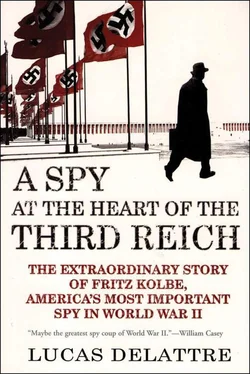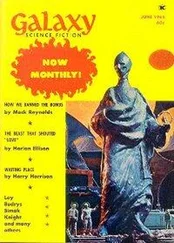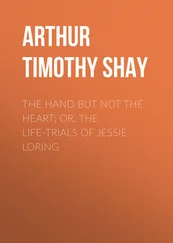agreement with the Soviets: Kappa message, October 7, 1944 and Boston document no. 426. The attempts at an approach to the Soviet Union by Peter Kleist had been mentioned in the American press in July 1944, but had been the subject of an official denial by the authorities of the Reich. Boston document no. 411.
a vast agricultural zone: Treasury Secretary Henry Morgenthau’s plan, revealed in September 1944, was widely used by Nazi propaganda to denounce America’s “criminal” intentions toward Germany.
prepared by Allen Dulles: Kappa message, October 7, 1944.
I should join you: Letter from Fritz Kolbe to Ernst Kocherthaler, November 14, 1944, National Archives.
supplied by the Americans: “With the camera, the volume of documents processed increased enormously.” Biographical document by Gerald Mayer and Fritz Kolbe.
while I was working?: Unpublished notebooks of Adolphe Jung.
confessed many years later: This episode is recounted in detail in “The Story of George” and in the biographical document by Gerald Mayer and Fritz Kolbe. Fritz Kolbe had the habit of drinking a cognac after moments of great anxiety. Morgan, “The Spy the Nazis Missed.”
population in the neighborhood: Episode recounted in the biographical document by Gerald Mayer and Fritz Kolbe and in “The Spy the Nazis Missed.” The Blockwart’s function was to be a liaison between the NSDAP and society. There were two million of these “little führers” in wartime. They observed the neighborhood, organized informing on deviant behavior, and the like.
caught him crossing Alexanderplatz: Biographical document by Gerald Mayer and Fritz Kolbe.
in the Dufourstrasse buildings: Complete Diary of Clandestine Radio Communications in Bern, Switzerland from November 24, 1944 through the Month of June 1945, National Archives.
carry out a search: Bern, National Archives.
a watch to be repaired: Biographical document by Gerald Mayer and Fritz Kolbe.
region for the present: Boston documents nos. 415 and 470. This information was transmitted by the OSS to President Roosevelt. Memorandum for the President, October 11, 1944, microfilm (entry 190c, MF1642, roll 18).
for a German defeat: Boston documents nos. 475, 478, and 479.
SS-Obersturmbannführer Eichmann: Boston document no. 471.
forced labor and “conscription”: Boston document no. 534.
of the Boston series: Boston document no. 542.
amounted to 440,000 people: Boston document no. 733.
the Jews of Budapest: In late December 1944, Fritz Kolbe informed the Americans that “Obersturmbannführer Eichmann has been ordered back to Berlin,” his mission accomplished. See Boston document no. 733.
dated December 1, 1944: Microfilm document (MF1642, roll 18).
the giving of guarantees: Ibid.
best deliveries of “Wood”: Evaluation of Boston Series, December 28, 1944, National Archives.
to his Washington colleagues: Hansjakob Stehle, “Der Mann, der den Krieg verkürzen wollte,” Die Zeit, May 2, 1986.
courier never traveled alone: Biographical document by Gerald Mayer and Fritz Kolbe.
legation in Bern, noted: Boston document no. 802.
“personal friend” of Emil Puhl: Boston document no. 355.
the IG Farben conglomerate: Boston document no. 804.
political asylum in Switzerland: In April 1945, several German diplomats left the legation in Bern and took refuge with Swiss friends. They returned to Germany after the fall of the Nazi regime. Handwritten notes of Ernst Kocherthaler, April 10, 1945, National Archives.
most of the trip: Biographical document by Gerald Mayer and Fritz Kolbe.
and the People’s Court: The ignoble chief prosecutor of the Nazi regime, Roland Freisler, died that day after being hit by a projectile while crossing the building’s courtyard.
close off the street: Unpublished notebooks of Adolphe Jung.
of the Foreign Ministry: Biographical document by Gerald Mayer and Fritz Kolbe. A large scale destruction of archives was to take place during the final weeks of the Nazi regime. Kappa message, April 5, 1945.
had not been obtained: Kappa message, February 5, 1945, in From Hitler’s Doorstep, p. 444. The question does indeed arise as to why the Americans never bombed Hitler’s headquarters in East Prussia, when Kolbe had indicated its precise location during his first visit in August 1943. According to the historian Klemens von Klemperer, the reason was the limited range of Allied aircraft, given the fact that the Soviets would not permit them to be refueled in the USSR.
decipher crossword puzzles: Kappa message, February 5, 1945.
Undersecretary, and President: Letter from Ferdinand L. Mayer to Whitney H. Shepardson, December 28, 1944, National Archives.
analyze the Kappa messages: OSS document dated February 20, 1945, entitled Special Unit, Kappa Material Organization and Handling, National Archives.
former right-hand man: Karl Wolff (1900–84) had been Heinrich Himmler’s right-hand man beginning in the mid-1930s. He was sent to Italy in 1943 to take charge of SS troops and protect what remained of Mussolini’s fascist regime. His role in the peaceful surrender of German troops in Italy in the spring of 1945 led to his being spared at the Nuremberg trials (at the time he benefited from the effective protection of Allen Dulles). He was again arrested in the early 1960s and sentenced to fifteen years in prison for his role in the deportation of hundreds of thousands of Jews to Treblinka. But he was released in 1970 for good behavior.
armed with improvised weapons: Fritz was enrolled for a few days in the Foreign Ministry brigade of the Volkssturm. Biographical document by Gerald Mayer and Fritz Kolbe.
singer of light music: Morgan, “The Spy the Nazis Missed.”
our friend D. [Dulles]: Unpublished notebooks of Adolphe Jung.
the password ‘George 25900’: Biographical document by Gerald Mayer and Fritz Kolbe.
people in the car: The presence of Margot Sauerbruch on this journey is reported by Morgan, “The Spy the Nazis Missed.” Morgan also indicates that Fritz Kolbe had proposed that Maria Fritsch come with him, but that she had refused, saying that her duty was to stay in the hospital. Margot Sauerbruch, the surgeon’s second wife (thirty years younger than he, thus born around 1905) was among Fritz Kolbe’s closest friends. Although she had been married to a close associate of Hitler in the Reich Chancellery, she was an anti-Nazi. She knew very precisely the nature of Fritz’s activities, unlike the surgeon, who was never told of the details. Autobiographical document written by Fritz Kolbe in January 1947.
or by SS units: This traversal of Germany is reported in a document that is probably a debriefing of Kolbe by Ernst Kocherthaler in early April 1945, a ten-page document whose first page is missing, National Archives. See also Morgan, “The Spy the Nazis Missed.”
Читать дальше











